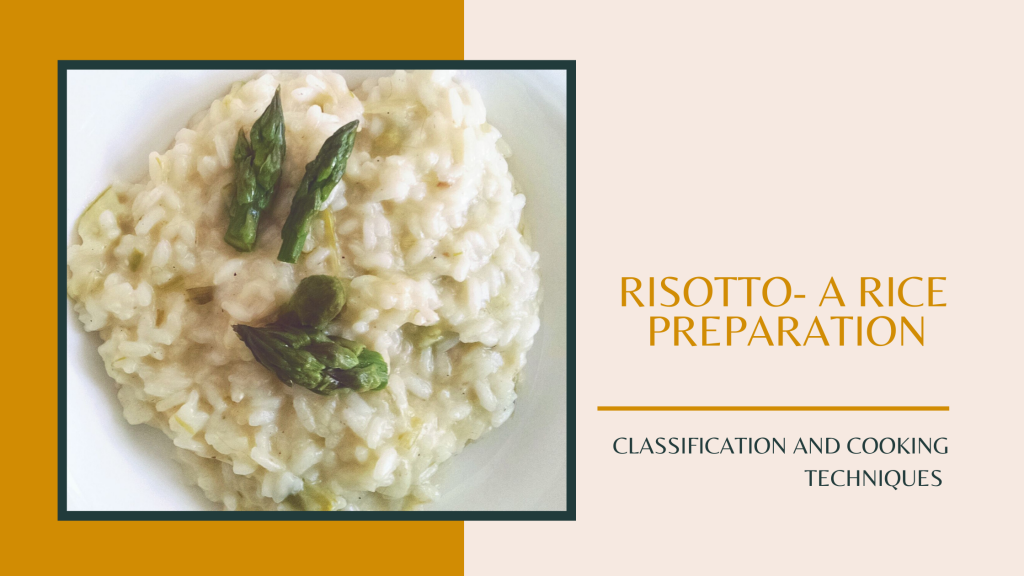
Rice is being the second most widely cultivated grain in the world and staple food of Southeast Asia, Africa, China, and Latin America. In the major rice-growing areas, it is known for each paddy field to yield its own particular strain. As a rule, the grain length determines how it should be cooked and whether it is suitable for sweet or savory dishes.
Rice is always cooked before eating. There are a number of ways of cooking rice. Some types benefit from being rinsed in cold water, while others should be left to soak before cooking. Rinsing is always suitable for most types of rice except RISOTTO from northern Italy.
A large quantity and variety of rice have been produced in Italy since the 14th century and its cultivation eventually reached Milan in the north. It is said that an apprentice from Flanders, used saffron as a pigment, added it to a rice dish at a wedding feast, It was the first recipe identifiable as risotto dates from 1809. It includes rice sautéed in butter, sausages, bone marrow, onions with hot broth with saffron gradually added. There is a recipe for a dish named as risotto in the 1854 Trattato di Cucina by Giovanni Vilardi, assistant chief chef to kings. However, the question of who invented the risotto in Milan remains unanswered today.

Risotto rice is short grain plump rice that grows in the region of Lombardy, Piedmont, and Veneto. These rice are classified by size, ranging from the shortest, Ordinario, Semi fino, Fino, and Super fino. Most of the risotto rice comes in Fino and Super fino varieties as they can hold their shape on slow cooking. Risotto rice must not be soaked as this would spoil its characteristic texture. The rice is not to be pre-rinsed, boiled, or drained, as washing would remove much of the starch required for a creamy texture. Rice designations of super fino, semifino and fino refer to the size and shape of the grains, and not the quality. In Italy, Risotto rice is being served before the main course or as an accompaniment to the main course.
The common way, Risotto is cooked with broth/stock until it reaches a creamy consistency. Many types of risotto contain butter, onion, white wine, and parmesan cheese.
Risotto rice contains amylopectin, low-amylose has the ability to absorb liquids and to release starch and so they are stickier than the long grain varieties. The principal varieties used in Italy are Arborio, Baldo, Carnaroli, Maratelli, Padano, Roma, and Vialone Nano.
Arborio: It is one of the most popular known risotto rice varieties. The Arborio name came from a town in the vermicelli region of North-west Italy. It has a large plump grain compared to finer varieties of risotto rice.

Vialone nano: It has a plump grain and a firm inner starch which gives risotto a slightly more bite.

Carnaroli: This premium variety of risotto rice is developed by a Milanese rice grower who crossed Vialone nano with Japanese rice. It has a soft starch outside which dissolves during cooking leaving behind the inner grain which gives it a firm bite.

Cooking Techniques
The rice is firstly cooked with onion, olive oil, or butter. This process is known as Soffritto.

It is then tossed properly with fat commonly known as Tostatura. At this stage white wine is added to de-glaze the pan and boiling stock is added gradually in small amounts stirring continuously.

The rice starts to release the starch from the outside of grains into surrounding liquid, developing a smooth and creamy texture. If required more stock can be added to cook the rice.

When the rice is cooked the pan is taken off from the heat and grated Parmesan Cheese and frozen butter is added to the risotto. This stage is known as Mantecatura.

It is served on flat dishes and easily spread out but not having excess watery liquid.

References
International Cuisine & Food Production Management – Parvinder S. Bali
The World Encyclopedia of Cooking Ingredients – Christine Ingram
